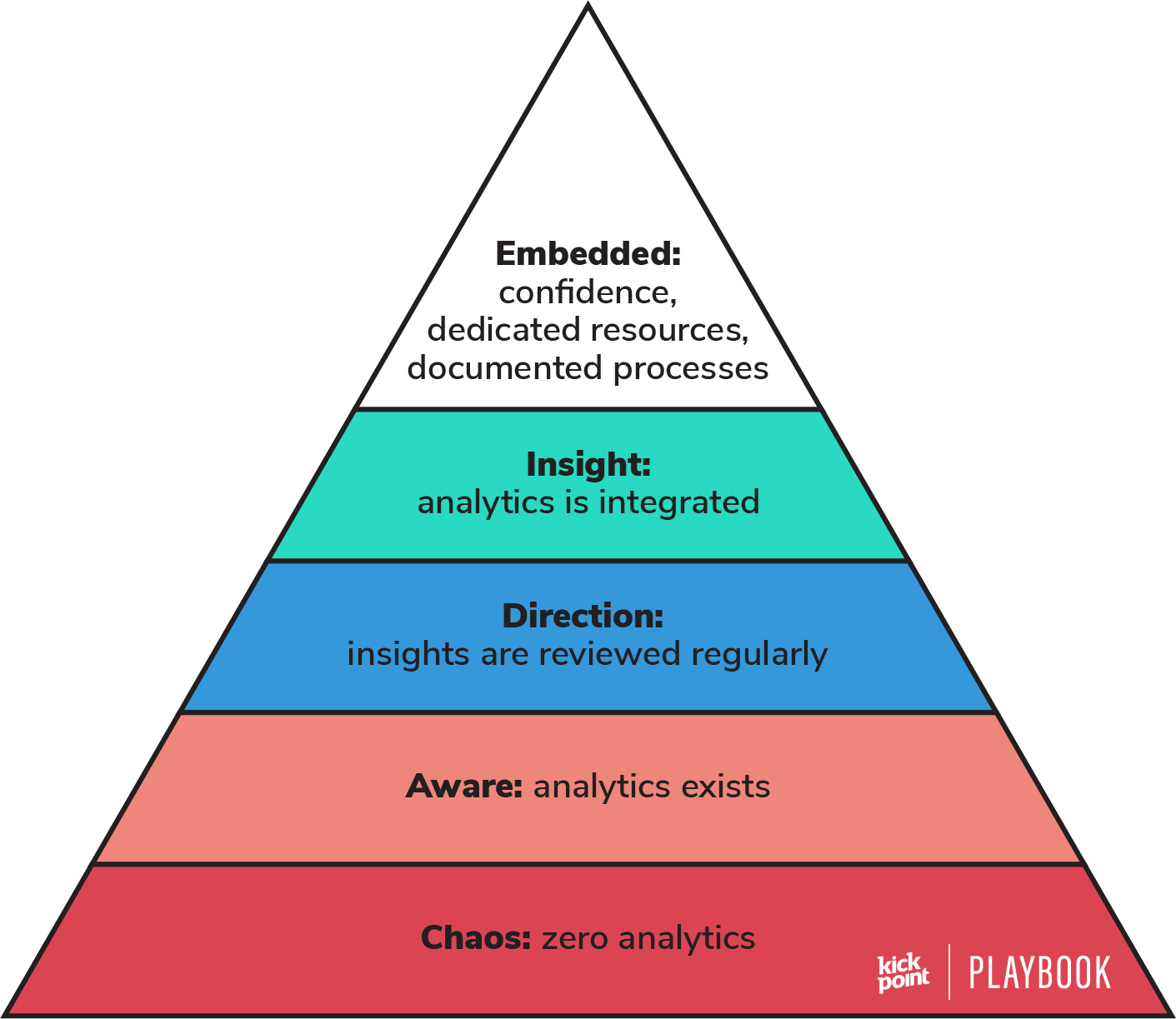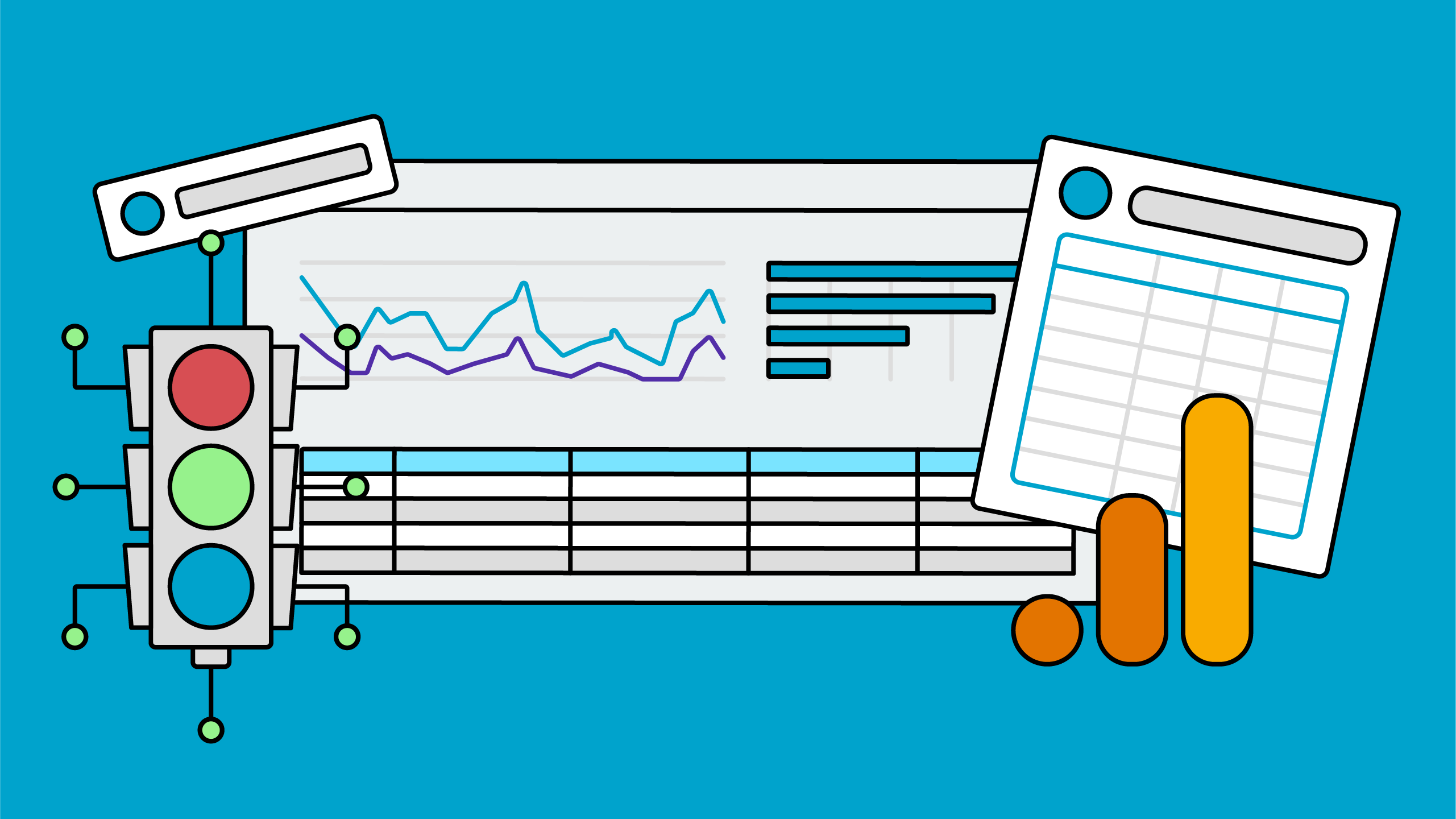Let’s set the scene: You’re in a meeting, defending your latest campaign budget. Your CEO asks about ROI, and you have the answer ready—a simple dashboard showing not just what worked, but why it worked, plus your notes on how to optimize the next campaign. Your recommendations? They aren’t based on hunches. Instead, they’re the result of predictive analytics that have consistently delivered results.
That probably sounds like a dream. And for many digital marketers, it is! The gap between the data we need and the data we have is typically so wide that we can’t see a way to cross it. Even though we have more data than we’ve ever had before, it isn’t helping. Many teams find themselves drowning in metrics rather than working from insights. Our challenge isn’t a lack of useful data—it’s knowing how to evolve your analytics practice to use that data systematically.
Here’s the truth: Getting to that level of analytics mastery isn’t about implementing the latest tool or AI chatbot or even hiring an army of data scientists. It’s about understanding and moving through what I call the Analytics Maturity Framework. It’s a five-level hierarchy that describes how organizations move from data chaos to data excellence.
Think of it as your roadmap to analytics success. Just as Maslow’s Hierarchy of Needs shows how humans progress from basic survival to self-actualization, the Analytics Maturity Framework reveals how organizations can evolve from making decisions based on gut feelings to leveraging predictive insights that drive real business outcomes.
In this guide, I’ll walk through each level of the hierarchy:
- Level 1: Chaos – Where many organizations start, drowning in data but starving for insights
- Level 2: Aware – Taking the first steps toward structured analytics
- Level 3: Direction – Building regular data practices and starting to see results
- Level 4: Insight – Integrating systems and making confident, data-informed decisions
- Level 5: Embedded – Achieving analytics excellence with organization-wide impact
Whether you’re just starting your analytics journey or you’re ready to move to the next level, this framework will show you exactly where you stand and what steps to take next. I’ll share real-world examples, practical implementation strategies, and expert insights to help you climb the hierarchy with confidence.
Stay ahead of the analytics curve
What is the analytics hierarchy?

Level 1: Chaos
At the foundation of my hierarchy lies what you probably know all too well: chaos. This is where there isn’t any analytics at all, or if there is, no one knows how to access it. In the chaos phase, decisions are made based on gut feelings rather than data. Strategies, if they exist, are driven by individual biases, and success or failure is decided on by feelings, not reality.
How you know you’re at Level 1:
- You can’t find basic campaign performance data—either for past or current campaigns.
- If numbers are reported, there isn’t any consistency. Different team members report different metrics from different sources.
- Decisions are made on instincts, past experience, or what someone learned from a speaker at a conference.
- Any campaign data that exists is recorded in scattered, unstructured locations such as an Excel spreadsheet on the marketing manager’s old laptop.
If this felt too real, I apologize. Something that I often say when we start working with a new client who is clearly in the throes of level 1 is “no one contacts an agency because things are going great”. Keep that in mind! Everyone has to start somewhere, and chaos is often the catalyst for change.
Level 2: Aware
At the aware level, your organization has taken its first steps toward data maturity. Analytics exist, and a small number of team members know how to access them. Basic insights, such as page views, are available on request. There may not be a lot of decision-making based on these metrics, but you have them and can get some idea of what’s working and what isn’t working.
But while you have some analytics, always keep in mind that analytics isn’t perfect, and can’t be perfect. Instead of chasing impossible perfection, focus on guiding people towards smarter, more confident decisions.
How you know you’re at Level 2:
- There are analytics such as GA4, but you have to go through a gatekeeper to get access.
- It’s possible to put together a campaign report, but it requires manual effort to pull data from multiple sources, which are then combined by hand into a single report—likely presented in a static format, such as a Word document.
- Decision-making comes after campaign results are put together and may only happen weeks or months after a campaign is finished.
- Key metrics are often impression-focused, and conversions are minimally reported, if they’re tracked at all.
This is the stage where you can start to build your foundations and gain the trust of leadership to move ahead with your analytics practice. At this point it’s critical to focus on standardizing your basic metrics and make sure that the right people have access to fundamental data before pushing ahead.
Level 3: Direction
The direction level marks the transition from basic to intermediate analytics maturity. At this level, insights are reviewed regularly, and data begins to influence decision-making—though it’s often used selectively to support existing assumptions. You may also be experiencing something that Juliana Jackson calls the “accountability vacuum”, where no one takes responsibility for doing anything based on these insights.
How you know you’re at Level 3:
- Analytics insights are reviewed regularly, regardless of whether or not you’re actively running campaigns.
- Decision-making can be data-influenced, but sometimes individual perspectives can override what analytics is telling you.
- There is a standardized process for reporting. This could be a manual process, but ideally there is some automation involved.
- Insights are found but there isn’t a clear path to responsibility to do anything based on those insights.
- You are just starting to get into cross-channel analytics instead of omni-channel. For example, you’re starting to be able to tie together an advertising network such as Meta with your GA4 data, and your CRM. You may not be full-circle yet, but the foundations are being put together.
This is the stage where you need to avoid the “confirmation bias trap”—where data is used to support predetermined conclusions rather than letting it guide strategy. This can happen when your data conflicts with long-held assumptions by your managers or leadership team. Often arguments will come back that the data isn’t trustworthy because “it isn’t accurate”—which is true, but it’ll never be 100% accurate and that shouldn’t stop you from making decisions.
I find that this is the level where a lot of organizations can get stuck, especially if the data isn’t telling them what they were expecting to hear. Getting past level 3 can involve reevaluating your goals and tactics—and ensuring that your goals are actually goals, not misnamed tactics. A goal charter can be a great way to get everyone on the same page and moving in the right direction.
Level 4: Insight
Finally you made it out of direction and now you’re at the insight level. This is where analytics truly begins to drive business value. At this level, data is integrated across systems, there are governance structures in place (or are being put into place), and the beginnings of predictive analytics are starting to appear.
How you know you’re at Level 4:
- Analytics, your CRM and/or customer data platform (CDP) and potentially a marketing automation solution are integrated.
- Decisions are made confidently based on results that are easily retrieved by any member of the team.
- Governance is in place to make sure that changes to analytics or related configurations are tracked and approved appropriately.
- There is enough trustable data in place that predictive analytics is starting to play a role in decision making.
This is where you see that the struggle to get past level 3 was worth it. You’re starting to see the results from your analytics investment in saved time and marketing spend. Decisions are made faster, they’re more accurate, and there is confidence in the process. Predictive analytics may be very new but they’re starting to unlock ideas for your team on how to put together future campaigns or other marketing work.
Level 5: Embedded
Finally you have reached the pinnacle of analytics maturity! Welcome to the embedded level. When you’re here, analytics isn’t just one of the tools that people access, it’s a foundational tool used by people in many parts of the organization. Predictive analytics and machine learning are integrated, and there’s widespread confidence in decisions made based on this information.
How you know you’re at Level 5:
- You’re probably not reading this because you don’t need to—unless you want to relive your journey to this point. (Insert training montage here.)
- Your organization has dedicated analytics resources with documented processes.
- Access to data is centralized and individuals can query it without requiring specialized knowledge or tools.
- Machine learning and predictive analytics are routinely used, and there is an organizational-wide confidence in analytics as a tool to guide decision making.
Although this is technically the top of the framework, your work doesn’t stop here. You’ll need to keep growing and evolving as analytics grows and evolves, by reviewing new tools, tactics, and processes as they are developed, and identifying potential risks. Make analytics education a core part of your onboarding process for new team members—regardless of their role—and you’ll make sure that analytics continues to be a foundational tool for your organization.
Don't let your analytics potential go untapped!
What level is your organization at in the hierarchy? Take the quiz
Before you can advance, you need to know where you stand. We don’t need a long survey to determine an organization’s level on the hierarchy. There are only four questions to answer. Take our quiz to find out where your organization stands in the framework. 👇
Analytics maturity framework self-assessment
What can you do right now to move up the analytics hierarchy
The best way to start moving up the hierarchy is to first put some basic processes in place. Some of these are very quick to implement, such as:
Standardize metrics across platforms and teams
When you report on impressions, and your PPC person reports on impressions, and your advertising agency reports on impressions, are you sure you’re all talking about the same thing? What about your analytics tools themselves, are they using the same words to mean different things?
A common mistake I often see is in attribution windows for conversions, where one tool will take credit for a conversion up to 7 days after a click, but GA4 will give out credit up to 90 days after the click. Which one is right? They’re both right—but you need to decide which one is right for you and stick with it.
Implement regular analytics reviews
Have you ever sat down with your team to review analytics on a regular basis? What about with leadership? Do you only pull a report when there is an important meeting coming up? Does your agency (if you use one) provide regular reports or a dashboard you can review whenever you need?
Don’t assume that everyone on your team is looking at analytics as much as you are. Put dedicated time aside in everyone’s calendar to review analytics. This can be a great time to start pushing toward the changes needed to move you up in the hierarchy as well!
Implement decision ownership protocols
When insights emerge from your analytics, immediately assign an owner responsible for assessment and potential action. Create a simple process, standard operating procedure, or task template that includes:
- The insight discovered
- Potential business impact
- Recommended action
- Decision owner (individual, not team)
- Decision deadline
- Expected outcome
This simple practice helps combat the ‘diffusion of responsibility‘—the phenomenon where people are less likely to take responsibility when multiple stakeholders are involved.
Document analytics configurations and procedures
Who has access to analytics? If something new needs to be recorded, who is responsible for that? Who has access to create conversions in your various analytics and advertising platforms?
Document your existing configuration and any procedures that your team currently has, either formal or informal. It can be as simple as writing down “If we need a new conversion in Google Ads, Purna can set that up” in a location that your entire team can access. That’s the start of documentation! Don’t feel like you have to create a 60 page process guide to call it documentation. Just start somewhere!
Build analytics training programs
Having analytics data is nice, but knowing what you can do with it is nicer. Put together or purchase an analytics training program for your team with milestones that they are expected to achieve by specific dates. Set up regular meetings to go over what the team is learning so everyone can benefit from the knowledge of others. Put time aside to read articles and newsletters to keep up on what’s happening in the analytics world. For example, I have a daily 15 minute meeting with myself to review articles and newsletters. Here are some of my favourites:
- The Playbook Huddle (Yes, I’m biased, but I write it so I’m allowed to be)
- Simmer Newsletter
- Mehdi Oudjida’s Looker Studio News
- Occam’s Razor by Avinash Kaushik
Develop organization-wide data literacy
A key step in getting your organization engaged with data is to get your organization excited about data. This can be a pretty dry topic, so by sharing quick wins with individuals at your organization, you can start making analytics feel more accessible.
For example, did someone on your team write a blog post or resource that continues to get loads of search traffic on a regular basis? Tell them! Who is the most Googled person at your organization? Let them know! Don’t just share the serious stuff, either. Is there something ridiculous that someone searched for and it showed up in your Google Ads keywords? That’s also fun to share.
Ready to start moving up?
No matter what level you’re at right now, the key to achieving analytics maturity is progress. Remember that progress isn’t always linear, and you may have setbacks, but two steps forward, one step back is still a step in the right direction. This is a marathon, not a sprint! You won’t be able to change your organization overnight—instead, you’ll get there, one step at a time.



